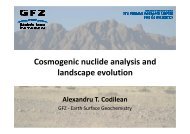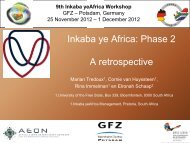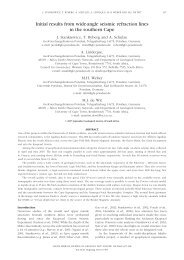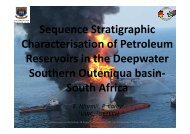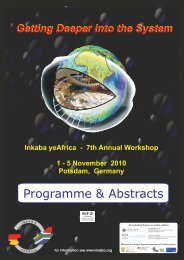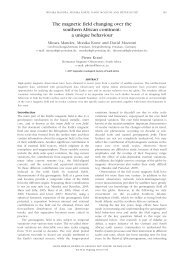South Africa - Inkaba.org
South Africa - Inkaba.org
South Africa - Inkaba.org
Create successful ePaper yourself
Turn your PDF publications into a flip-book with our unique Google optimized e-Paper software.
Climate/sealevel fluctuations along the <strong>South</strong>ern<br />
<strong>Africa</strong>n West Coast: regional and global context<br />
D Roberts 1<br />
1. Council for Geoscience, <strong>South</strong> <strong>Africa</strong>, droberts@gescience.<strong>org</strong>.za<br />
ABSTRACT<br />
Long term global trends in Cenozoic climatic/oceanographic evolution are mediated by fundamental<br />
geological processes such as the changing configuration of landmasses. These in turn have major<br />
impacts on ecosystems at all scales. However, the underlying forces driving some global trends remain<br />
obscure. Whereas the Oligocene lowstand can be attributed to the final separation of Gondwana<br />
landmasses allowing free flow of the Antarctic Circumpolar Current, neither the subsequent Early-<br />
Middle Miocene recovery, nor the early Piocene warm period have obvious main causes.<br />
Superimposed on these fundamental (global) trends are regional events such as tectonism, which<br />
impinge on local climate and relative sea levels. The <strong>South</strong> <strong>Africa</strong>n west and southern coasts form an<br />
ideal field laboratory for studying late Cenozoic climatic/oceanographic histories because of the<br />
extremely rich palaeorecord contained in the onshore littoral and fluvio-estuarine deposits, as<br />
represented in a large number of well studied sites. The manner and extent to which they link with the<br />
regional and global record may illuminate some of these important issues. In particular, many new<br />
dates of major events based on palaeontology, radiometric methods, palaeomagnetics and luminescence<br />
have provided fresh insights into the chronological sequence of events. Regionally, the southern<br />
<strong>Africa</strong>n subcontinent represents a passive intraplate, trailing edge setting, which is also removed from<br />
glacial influence and has experienced no Cenozoic volcanic activity. Rates of vertical crustal motion<br />
are consequently low and late Cenozoic shoreline datums chiefly reflect glacio-eustatic sea level<br />
history. The tectonic stability of this region is therefore highly favourable for the study of glacioeustatic<br />
sea level fluctuations. However, some authors have suggested otherwise, positing that the<br />
region has undergone sharp and asymetric periodic uplift in the Neogene and the evidence cited for this<br />
viewpoint is critically reviewed. This paper is essentially a critical review of the literature, but includes<br />
some unpublished novel observations.<br />
Keywords: Sea level; climate; late Cenozoic; southern <strong>Africa</strong>; chronology<br />
71



